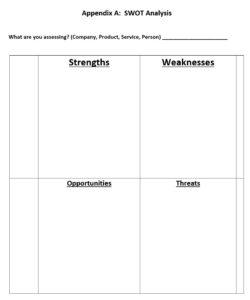Ever been asked to complete a SWOT Analysis?
Ever wonder why? Or what you should do with it?
SWOT stands for:
- Strengths
- Weaknesses
- Opportunities
- Threats

To complete one, you first pick a subject. This could be a product, a competitor, or most often, yourself. Then, in a four-box diagram, you identify the strengths, weaknesses, opportunities, and threats to your subject.
A SWOT is a great way to evaluate anything in your business. They provide insight into how you and others on your team view the subject. The most critical part is that it compares you (the subject of the SWOT) against your competition. And that is what your customer does every day. You are only one of the many salespeople driving down your customer’s driveway. Each time a competitor shows up, your customer does a mini-SWOT analysis in their head to decide who they want to do business with.
For example, recently I was developing a training session for a sales team that needed to build their confidence around themselves and their company. So, I had each person enter their name at the top of the SWOT analysis. Then, I asked them to fill all four boxes.
After receiving several completed SWOTs, I realized how many times I had been asked to complete as a salesperson. However, I couldn’t remember one instance of the instructor explaining to me what to really do with the analysis. We just completed them, shouted out some of our answers during a debrief, but never really discussed how to use the information.
To remedy this, I had this group complete the SWOT, but then had them take each of the four boxes one step further in using the info they provided.. For brevity, I selected one entry line from each of their four boxes and demonstrate what they need to do with those answers.
S = Strengths.
- Their answer: “I really care for and value my customers”
- My request: First, confirm that this strength is unique versus your competitors. If everyone does this or has this characteristic, then it’s not a strength. Second, please describe how your customer gains value ($, time, or emotion) from that strength. Lastly, can you quantify that value somehow?
W = Weaknesses
- Their answer: “Not organized as much as I should be”
- My request: How can you mitigate this weakness? Can you improve on it? Delegate it? What about ignoring it? If you ignored it, would you, your company, or your customer suffer in any way? If so, by how much?
O = Opportunities
- Their answer: “Customers who buy product “A” but don’t buy our complimentary product “B”.
- My request: Select the largest opportunity and 3-5 of the most likely customers that would benefit from product “B”. Schedule small steps on your Outlook calendar to engage those customers in a discussion on product “B”. Treat them just like you would a prospect. Confirm they are aware that you even have the product and how it helps them. Then apply your strengths to that opportunity to take advantage of it.
T = Threats
- Their answer: “The farm economy is terrible going into 2025”My request/response: That’s a threat to your customer and not to you. It is also not unique to you and your company. It’s a threat across all of Ag, including your competitors. Yet, there are steps you take to pre-empt this threat, let’s move to another threat.Their next response: “We lack equipment technicians to service the equipment we sell”.
- My request: Like anyone who safeguards against a threat, we want them to predict the most likely scenario and then do pre-emptive steps to reduce the risk of that threat. For example, all of us have had the miserable experience of going through TSA at the airport. That is a pre-emptive step to safeguard against the threat of terrorists. We expect the “people in charge” to prevent threats with pre-emptive planning. In our case, we know we have a lack of technicians in our equipment dealership. Our customers expect us to pre-empt threats as much as possible. We know we are going to have back logs of service work, leading to impatient/frustrated customers, leading to over worked techs and short-tempered service managers. Communication issues on the status of repairs will become a problem as customers want to know when their equipment will be repaired. However, your service manager doesn’t always know the exact time because some jobs take longer to complete than planned.
As a salesperson, you probably don’t turn wrenches so you don’t know what to do. You may even feel helpless when trying to sell or help your customer in this situation.
First, realize there is a lot you can do. And many of those steps need to be done ahead of time as a pre-emptive measure just like our friendly TSA agents do. In your case, I first recommend that you develop a great working relationship with your service manager. Then, at a slower, more sane time in his schedule, ask to have a discussion with him. Seek to understand how he accomplishes his work flow of jobs. How does he prioritize jobs when he is limited on technicians? How long has he done that priority technique and how did he develop it? Where, when, and how does it fall apart? What can customers and salespeople do to make it easier for him to be more efficient and effective? From a communication standpoint, how can you, him, and customers communicate so everyone knows what is going on with the status of repairs? At a bare minimum, any salesperson can increase the amount of communication flowing from their company to the customer.
The taxi industry is a great example. Years ago, you either hailed a cab down on the open street or called the cab company and asked them to send one to you. If you were in a rush, you worried if the taxi was on its way, did they forget you, should you take another taxi?
Uber/Lyft changed the communication game for the whole industry. One of the best parts of using them is watching that little car symbol navigate the map towards you in real time. While that might not be possible in your dealership, wouldn’t it be awesome for you or your customer to see an image on the screen as their combine is brought in for repairs? Better yet, what if the customer got a text message or email on real time status updates as their equipment went from the lot, into the shop, and is being worked on?
SWOT is a powerful tool that’s free to use and can really help you hone in on how you can improve your competitiveness in the market. Use these four steps when completing your next SWOT to expand your strengths, mitigate your weaknesses, take advantage of opportunities, and pre-empt any threats to you!


